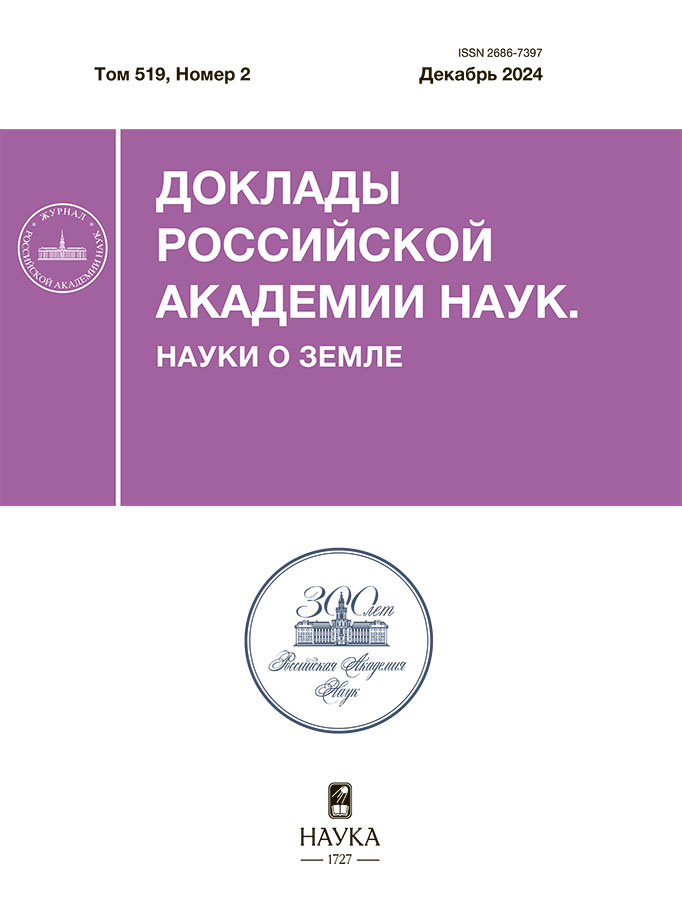Physico-chemical factors favoring greisen tin deposits formation: a new look at the old problems
- Authors: Aranovich L.Y.1, Bortnikov N.S.1, Akinfiev N.N.1
-
Affiliations:
- Institute of Geology of Ore Deposits, Petrography, Mineralogy, and Geochemistry, Russian Academy of Sciences
- Issue: Vol 519, No 2 (2024)
- Pages: 49-55
- Section: GEOCHEMISTRY
- Submitted: 04.06.2025
- Published: 28.12.2024
- URL: https://snv63.ru/2686-7397/article/view/682448
- DOI: https://doi.org/10.31857/S2686739724120069
- ID: 682448
Cite item
Abstract
Physico-chemical factors favoring formation of greisen tin deposits are evaluated based on the original data on composition of melt and fluid inclusions in magmatic and ore-forming minerals from Tigrinoe tin-tungsten deposit, Russian Far-East, and on the literature. We show that for the granitoid-related deposits the factors include: relatively low-temperature and low-pressure (720–770 °C/0.7–2 kbar, 3–6 km) granites formed under reducing oxygen fugacity (fO2 below fayalite-magnetite-quartz, QFM buffer), that is indicated by absence of magnetite/presence of ilmenite, and by reduced positive Ce-anomaly in magmatic zircon (1); low-salinity fluid inclusions in magmatic quartz (2); fluid inclusions with the СН4/СО2 ratio of 0.1–0.3 in the ore-vein minerals (3). A number of problems related to the origin of tin-tungsten deposit need further studies. In the first place, it concerns the role of fluorine in magmatic accumulation and hydrothermal transport of Sn. Partitioning of Sn and W between granite melt and fluids under reducing fO2 below QFM buffer also has to be experimentally evaluated.
Full Text
About the authors
L. Y. Aranovich
Institute of Geology of Ore Deposits, Petrography, Mineralogy, and Geochemistry, Russian Academy of Sciences
Author for correspondence.
Email: lyaranov@igem.ru
Academician of the RAS
Russian Federation, MoscowN. S. Bortnikov
Institute of Geology of Ore Deposits, Petrography, Mineralogy, and Geochemistry, Russian Academy of Sciences
Email: lyaranov@igem.ru
Academician of the RAS
Russian Federation, MoscowN. N. Akinfiev
Institute of Geology of Ore Deposits, Petrography, Mineralogy, and Geochemistry, Russian Academy of Sciences
Email: lyaranov@igem.ru
Russian Federation, Moscow
References
- Аранович Л. Я. Флюидно-минеральные равновесия и термодинамические свойства смешения флюидных систем // Петрология. 2013. Т. 21. С. 588–599.
- Барсуков В. Л. Геохимия олова // Геохимия. 1957. Т. 1. С. 41–52.
- Бортников Н. С. Геохимия и происхождение рудообразующих флюидов в гидротермально-магматических системах в тектонически активных зонах // Геология рудных месторождений. 2006. Т. 48. № 1. С. 3–28.
- Крылова Т. Л., Pandian M. S., Бортников Н. С. и др. Вольфрамовые и оловянно-вольфрамовые месторождения Дегана (Раджастан, Индия) и Тигриное (Приморье, Россия): состав минералообразующих флюидов и условия отложения вольфрамита // Геология рудных месторождений. 2012. Т. 54. № 4. С. 329–349.
- Наумов В. Б., Дорофеева В. А., Миронова В. Ф. Физико-химические условия образования гидротермальных месторождений по данным изучения флюидных включений. 1. Месторождения олова и вольфрама // Геохимия. 2011. Т. 49. № 10. С. 1063–1082.
- Смирнов С. З., Бортников Н. С., Гоневчук В. Г., Гореликова Н. В. Составы расплавов и флюидный режим кристаллизации редкометальных гранитов и пегматитов Тигриного Sn-W месторождения (Приморье) // ДАН. 2014. Т. 456. № 1. С. 95–100.
- Audetat A. The Metal Content of Magmatic-Hydrothermal Fluids and Its Relationship to Mineralization Potential // Economic Geology. 2019. V. 114. P. 1033–1056. http://doi.org/10.5382/econgeo.4673
- Bortnikov N. S., Aranovich L. Y., Kryazhev S. G. et al. Badzhal tin magmatic-fluid system, Far East, Russia: Transition from granite crystallization to hydrothermal ore deposition // Geology Ore Deposits. 2019. V. 61. P. 199–224.
- Burnham A. D., Berry A. J. An experimental study of trace element partitioning between zircon and melt as a function of oxygen fugacity // Geochim. Cosmochim. Acta. 2012. V. 95. P. 196–212. http://doi.org/10.1016/j.gca.2012.07.034
- Churakov S. V., Gottschalk M. Perturbation theory based equation of state for polar molecular fluids: I. Pure fluids // Geochimica Cosmochimica Acta. 2003. V. 67. P. 2397–2414.
- De Capitani C., Petrakakis K. The computation of equilibrium assemblage diagrams with Theriak/Domino software // American Mineralogist. 2010. V. 95. P. 1006–1016. http://doi.org/10.2138/am.2010.3354.
- Duc-Tin Q., Audetat A., Keppler H. Solubility of tin in (Cl, F)-bearing aqueous fluids at 700оC, 140 MPa: A LA-ICP-MS study on synthetic fluid inclusions // Geochimica Cosmochimica Acta. 2007. V. 71. P. 3323–3335. http://doi.org/10.1016/j.gca.2007.04.022
- Gaschnig R. M., Rudnik R. L., McDonough W. F. et al. Compositional evolution of the upper continental crust through time, as constrained by ancient glacial diamictites // Geochimica Cosmochimica. Acta. 2016. V. 186. P. 316–343. http://doi.org/10.1016/j.gca.2016.03.020
- Holland T. J. B., Powell R. An improved and extended internally consistent thermodynamic dataset for phases of petrological interest, involving a new equation of state for solids // Journal Metamorphic Geology. 2011. V. 29. P. 333–383. http://doi.org/10.1111/j.1525-1314.2010.00923.x
- Hu X., Bi X., Hu R., Shang L., Fan W. Experimental study on tin partition between granitic silicate melt and coexisting aqueous fluid // Geochemical Journal. 2008. V. 42. P. 141–150. http://doi.org/10.2343/geochemj.42.141
- Lehmann B. Formation of tin ore deposits: A reassessment // Lithos. 2021. V. 402–403. 105756. http://doi.org/10.1016/j.lithos.2020.105756
- Palme H., O’Neill H. St. S. Cosmochemical estimates of mantle composition / In: Treaties on Geochemistry. Ed. 2014. P. 1–39.
- Romer R. L., Kroner U. Sediment and weathering control on the distribution of Paleozoic magmatic tin–tungsten mineralization // Mineralium. Deposita. 2015. V. 50. P. 327–338. http://doi.org/10.1007/s00126-014-0540-5
- Romer R. L., Kroner U. Phanerozoic tin and tungsten mineralization – tectonic controls on the distribution of enriched protoliths and heat sources for crustal melting // Gondvana Research. 2016. V. 31. P. 61–92.
- Schmidt С., Gottschalk M., Zhang R., et al. Oxygen fugacity during tin ore deposition from primary fluid inclusions in cassiterite // Ore Geology Reviews. 2021. V. 139. 104451. http://doi.org/10.1016/j.oregeorev.2021.104451
- Zhao L., Shao Y., Zhang Yu., et al. Differentiated enrichment of magnetite in the Jurassic W–Sn and Cu skarn deposits in the Nanling Range (South China) and their ore-forming processes: An example from the Huangshaping deposit // Ore Geology Reviews. 2022. V. 148. 105046. http://doi.org/10.1016/j.oregeorev.2022.105046
Supplementary files

















